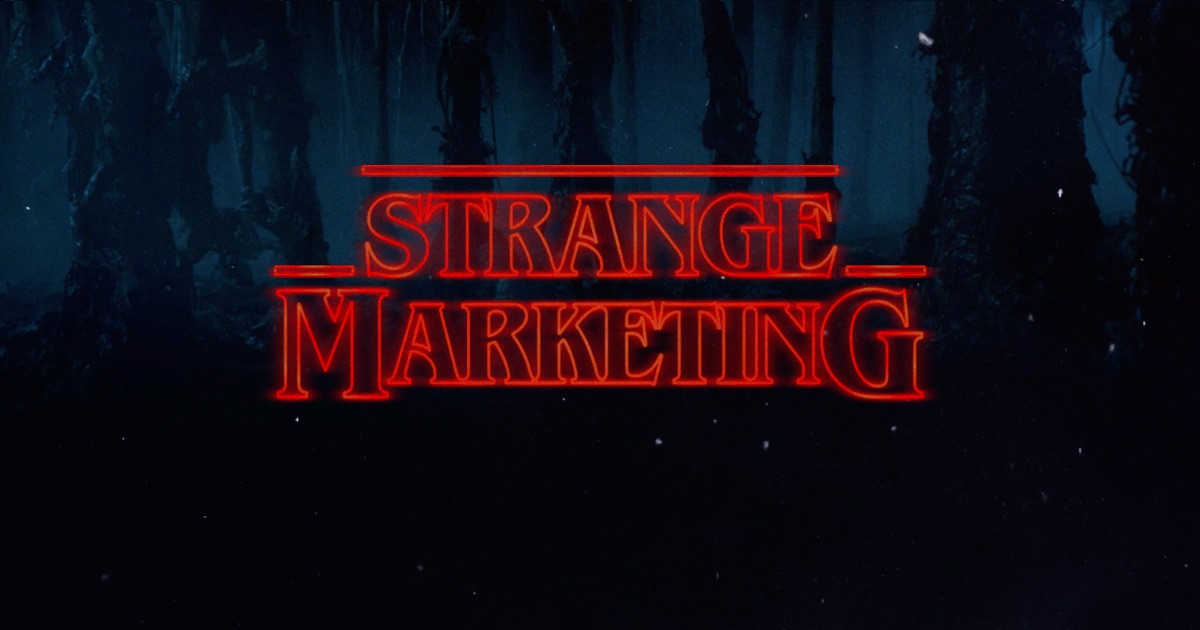The world is holding its breath for Stranger Things Season 5, the grand finale that promises to close one of Netflix’s biggest chapters ever. But beyond the monsters, mystery, and the small-town chaos of Hawkins, there’s something even more fascinating about the show, its marketing.
From day one, Stranger Things wasn’t just a sci-fi series. It was a brand built with precision, nostalgia, and emotion. Every season came with its own marketing heartbeat, each campaign teaching marketers like us something about storytelling, consistency, and how to make an audience feel like they’re part of something bigger. Lets dive into the Upside Down of marketing together and see what we can learn from the Stranger Things team.
Lesson 1: Build an experience, not just a product.
When Stranger Things first arrived, nobody expected it to become a global phenomenon. But the creators didn’t just sell a story, they built an entire world, an experience that we never had before. The neon logo, 80s synth music, walkie-talkies, and retro brands like Eggo waffles weren’t random props. They were emotional anchors that pulled viewers into a world that felt both familiar and strange.
For marketers, this is gold. Whether you’re promoting a fitness brand or a skincare line, your goal isn’t just to sell something, it’s to invite people into a world they want to live in. The Stranger Things brand never broke its visual or emotional consistency, and that’s exactly why fans stayed hooked.
Lesson 2: Power of collaboration.
One of the show’s biggest marketing wins came from its partnerships. Remember when Coca-Cola reintroduced New Coke in 2019 to celebrate Season 3? Or when Baskin-Robbins turned its stores into Scoops Ahoy ice cream parlors? Those weren’t gimmicks, they were immersive brand experiences.
For the final season, Target has gone all in with Netflix to bring the world of Hawkins to life in its stores, complete with themed merchandise and nostalgic 80s packaging. These collaborations didn’t just promote the show, they expanded its universe.
If you are a marketer, this is your cue, find partnerships that fit your story. Don’t just collaborate to be trendy. Collaborate to create a shared experience.
Lesson 3: Create experiences, not just ads.
Stranger Things didn’t limit itself to TV screens. It spilled into social media, pop-up events, AR games, and fan-led communities. Netflix built real Hawkins living rooms in malls, hosted Upside Down experiences, and even created TikTok filters that let fans transform into their favorite characters.
This is what modern marketing looks like, experiences that make people feel. The Stranger Things team didn’t just tell you about the Upside Down, they made you walk through it.
Lesson 4: Nostalgia is emotional currency.
The show’s 1980s setting isn’t just a creative choice, it’s a masterclass in emotional marketing. It taps into nostalgia, the most powerful emotion in branding. The music, clothes, language, even the old-school walkmans, they all remind viewers of a simpler time.
That’s why brands like New Coke or Target’s vintage packaging campaigns hit so hard, they don’t just sell a product, they sell a memory.
For marketers, nostalgia doesn’t always mean retro. It means understanding what your audience misses or wishes they could feel again, and giving it back to them.
Lesson 5: Keep the momentum alive.
Another smart move, the Stranger Things team never lets hype die. Between seasons, they release teasers, behind-the-scenes footage, fan art features, and interactive social challenges. For Season 5, Netflix is splitting the release into multiple parts to keep the conversation going for months.
That’s the golden rule of audience retention, never give them a reason to move on. Keep feeding curiosity. Keep the dialogue open.
What marketers can learn
Stranger Things didn’t just dominate streaming, it redefined how to market entertainment. It proved that emotion beats algorithms, stories beat sales pitches, and consistency builds cult followings.
If youare a marketer or business owner, take notes from Hawkins, build a world your audience wants to live in, collaborate wisely, not randomly, create immersive experiences, not just campaigns, play with nostalgia, but keep it fresh, stretch the story, don’t rush the ending. The truth is, Stranger Things succeeded because it never treated its audience like viewers, it treated them like insiders. Every season pulled us deeper, and every campaign made us feel like we belonged to something special.
As the final chapter approaches, one thing is clear, Stranger Things didn’t just change how we watch stories. It changed how stories are sold. If you wish to build your brand like how stranger things team did all you have to do is just fill the form and wait for our call. We will turn the fate of your business upside down.

